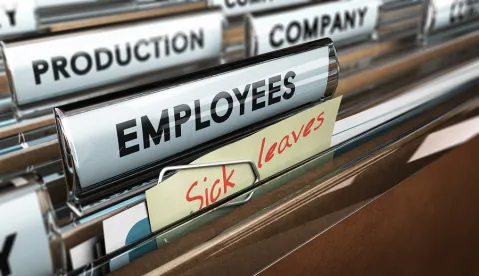On April 3, 2020, New York State Governor Andrew Cuomo signed into law a statewide Paid Sick Leave Law (the “Law” or “PSLL”). The PSLL is in addition to the mandatory COVID-19 Paid Sick Leave Law that was enacted on March 18, 2020 referenced in our previous bulletin.
The PSLL, codified as section 196-b of the N.Y. Labor Law, allows employees to begin accruing sick leave as of September 30, 2020 and using sick leave as of January 1, 2021. The Law, which covers all employers in New York State, gives employees at least 40 hours of paid or unpaid sick leave up to a maximum of 56 paid hours, depending on the size and net income of the employer. The PSLL does not prohibit or prevent an employer from providing an amount of sick leave, paid or unpaid, in excess of the Law’s requirements.
Amount of Sick Leave
-
Employers with 4 or less employees in a calendar year and a net income of $1 million or less in the previous tax year: Must provide each employee with at least 40 hours of unpaid sick leave each calendar year.
-
Employers with 4 or less employees in any calendar year and a net income of more than $1 million in the previous tax year: Must provide each employee with at least 40 hours of paid sick leave each calendar year.
-
Employers with between 5 and 99 employees in any calendar year: Must provide each employee with at least 40 hours of paid sick leave each calendar year.
-
Employers with 100 or more employees in any calendar year: Must provide each employee with at least 56 hours of paid sick leave each calendar year.
In order to determine the number of employees pursuant to this subdivision, a calendar year shall mean the 12-month period from January 1 through December 31.
Accrual
Employees may accrue sick leave at a rate of not less than 1 hour for every 30 hours worked, beginning at the commencement of their employment or the effective date of the law (September 30, 2020). Alternatively, employers may front-load employees’ sick leave at the start of the year.
Permissible Uses of Sick Leave
An employee may use the state paid sick leave for the following:
-
A mental or physical illness, injury, or health condition of an employee or the employee’s family member, irrespective of whether such illness, injury or health condition has been diagnosed or requires medical care at the time the employee requests leave;
-
The diagnosis, care or treatment of an existing health condition of, or preventive care for, an employee or an employee’s family member, or a ward for whom the employee is the guardian; or
-
An employee or an employee’s family member who is a victim of domestic violence, a sexual offense, stalking, or human trafficking, to avail themselves of services or assistance.
“Family member” is defined as an employee’s child, spouse, domestic partner, parent, sibling, grandchild or grandparent, and the child or parent of an employee’s spouse or domestic partner. A “parent” includes a biological, foster, step- or adoptive parent, or a legal guardian of an employee, or a person who stood in loco parentis when the employee was a minor child. A “child” means a biological, adopted or foster child, a legal ward, or a child of an employee standing in loco parentis.
Rate of Pay for Sick Leave
The PSLL requires employers to compensate employees who are using paid sick leave at the greater of: (i) their regular rate of pay, or (ii) the applicable minimum wage established by Labor Law Section 652.
Unused Leave
An employee’s unused sick leave shall be carried over to the following calendar year, provided, however, that: (i) an employer with fewer than 100 employees may limit the use of sick leave to 40 hours per calendar year; and (ii) an employer with 100 or more employees may limit the use of sick leave to 56 hours per calendar year.
An employer is not required to pay an employee for unused sick leave upon such employee's termination, resignation, retirement, or other separation from employment.
Recordkeeping and Other Requirements
Employees may request to use the paid sick leave orally or in writing. The Law prohibits employers from requiring an employee to disclose the nature of any medical condition or of any domestic violence/sexual offense matter necessitating the need for leave.
Employees who take leave under the PSLL must be restored to their position upon completion of the leave.
Employers may not retaliate against an employee for asserting any right granted under the PSLL, including taking or requesting leave. When an employee returns from paid sick leave, the employee must be restored to his or her former position with the same pay and other terms and conditions of employment.
Upon the oral or written request of an employee, an employer shall provide a summary of the amounts of sick leave accrued and used by such employee in the current calendar year and/or any previous calendar year. The employer must provide the information within 3 business days. In addition, payroll records must reflect the amount of sick leave that has been provided to each employee.
Interaction with Existing Leave Policies and Laws
If an employer already has an existing paid leave policy that satisfies all of the requirements under the PSLL (accrual rate, carryover, and permissible uses), the employer is not required to provide additional sick leave.
Collective bargaining agreements may provide for benefits comparable to what the Law requires – in the form of leave, compensation, or other benefits – or may provide for sick leave different from what is required by the PSLL. Any such collective bargaining agreement must specifically acknowledge the PSLL.
The PSLL states that cities with populations of 1 million or more (currently, New York City is the only such city in New York State) may enact or enforce local laws or ordinances that impose stricter standards or requirements relating to sick leave. The PSLL states that any paid sick leave benefits provided by a sick leave program enforced by a municipal corporation in effect as of September 30, 2020 shall not be diminished or limited as a result of the PSLL. This suggests that the sick leave provided by the PSLL is in addition to leave provided by the New York City Earned Safe and Sick Time Act. Employers should remain aware of the additional safe leave uses granted under the NYC Sick and Safe Leave Law.
The NYS Department of Labor will likely issue guidance under the PSLL in order to clarify the requirements of the Law.




 />i
/>i

